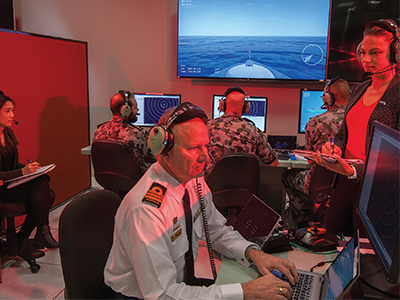Integrating an air vehicle capability in the maritime environment

The Royal Australian Navy (RAN) is investing heavily in its future capability and will deliver a Maritime Tactical Uninhabited Aerial Systems (MTUAS) capability to every major fleet unit. MTUAS encompass an air vehicle, control stations and people to operate and maintain them.
The receiving fleet units will range from the future offshore patrol vessel, to future surface combatants (including support vessels and the large deck amphibious vessels).
DST's support to this project includes an analysis of integration options for effectively incorporating an UAS capability into the ship environment. DST delivered a graduated suite of integration concepts for the MTUAS to the RAN late in 2016. Each option is a different balance of technical investment and operational value. To study part of this trade space DST scientists collaborated to test the concepts in a series of human-in-the-loop simulation-based trials.
Two stage experimental study
DST was asked to study the different levels of integration for their impact on operator performance to support the operational use of the maritime UAS capability. A two stage experimental study was designed to assess the physical integration of UAS crew into command spaces and integration of data from the UAS into the ship's combat management system. The first experiment was called Exercise Sky Kraken, held in 2017.
"This experiment allowed us to study the implications of UAS operators being isolated from or co-located with the Commander and/or Picture Compiler by actually performing the tasks that would need to be done," says Defence scientist Dr Susan Cockshell.
"Short of doing the real thing at sea, this is the best way for us to truly understand the type of maritime UAS integration that needs to be delivered to the Navy."
Sky Kraken is the first of a set of planned trials to study the integration of uninhabited aerial systems and the various combat systems across the RAN surface fleet. The report from this and subsequent trials in this series will directly inform the integration approach that offers the best capability for the RAN as part of the Joint Force. This work is being conducted in support of the RAN's Naval Aviation Plan 2040.
DST collaborated with industry partners CAE, AVTol, SimSol and Consilium, all of which worked cooperatively to produce a simulation system that was fit for the purpose of this trial.
Integrated ship command environments
The laboratory at DST allows the team freedom to deploy consoles wherever required, display information on large wall screens, facilitate a chat system, capture video and support the RAN participants through a DST developed communication system allowing different circuits to be created.
The next step is to extend the scope of the simulation to evaluate integration of an uninhabited air vehicle into a surface task group, with an increased capability that includes radar and electronic warfare sensors in addition to electro-optical. This will allow DST and Navy colleagues to explore richer levels of integration, such as direct integration of UAS data into the combat system, and how that integration can best support RAN crewing of these systems to achieve overall operational effectiveness and efficiency.

